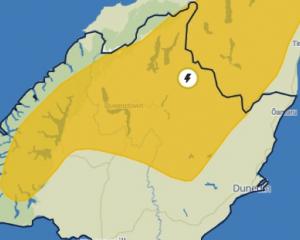Cyclone Hola is on track for New Zealand and could directly hit the North Island early next week - "if we are unlucky", say weather forecasters.
Vanuatu is this morning being whipped by gale-force winds as Hola brushes past the nation. Some models predict it could hit the North Island early next week.
The Category 4 storm was last night about 315km west of Efate, the small island home to Vanuatu's capital city Port Vila, according to the Vanuatu Meteorology and Geo-Hazards Department.
Winds close to the centre of the storm were estimated to be about 165km/h and damaging gale-force winds were expected to hit the bottom half of the island nation - the Shefa and Tafea provinces - overnight and tomorrow.
The seas would remain very rough with heavy to phenomenal swells over the Shefa province, heavy rainfalls, thunderstorm and flash flooding over low lying areas.
Hola had been moving slowly over Vanuatu during the past two days, and reports were that gale-force winds were collapsing some houses.
The roof of a classroom was blown off and some houses collapsed on Ambrym as the cyclone arrived, it was reported.
Unicef's Andrew Parker told RNZ this morning there were no reports of casualties and people were more aware of how to stay safe after their experience of Cyclone Pam three years ago.
It appeared homes and crops had been affected on the islands of Malekula, Ambrym and Ambae.
Vanuatu's National Disaster Management Office was co-ordinating the assessment and response to the disaster.
The storm was moving in a south-southwest direction and would head closer to New Caledonia over the next six hours although models showed it turning more to the east tomorrow morning.
The change in direction would mean the main island of New Caledonia and Vanuatu were expected to avoid a direct hit by Hola although it looked likely to pass directly over the Loyalty Islands tomorrow evening.
The Fiji Metservice expected the storm could increase to a Category 5 tomorrow.
Three forecasting models for Tropical Cyclone Hola predict the storm is likely to hit New Zealand's North Island early next week.
Two models, from the UK Met Office, show Hola could hit the Bay of Plenty on Monday. It would be the third cyclone this season to affect New Zealand.
The third model, from the European Centre for Medium-Range Weather Forecasts, predicts it could make landfall about 6pm on Monday.
MetService New Zealand lead meteorologist Mark Todd said computer models were still struggling to give an accurate track but it was looking increasingly likely the storm would affect New Zealand.
"If we are lucky it will pass just to the north of us. If we are unlucky, it could be a direct hit into the North Island," Todd said.
"By then it will become an extra-tropical system, as always happens, but if it does make a direct hit there will be heavy rain and high winds."
Meanwhile, another low had been wreaking havoc as it moved slowly over the North Island.
Parts of the Hawke's Bay had been hammered by more than 300mm of rain over the past 24 hours forcing campers and some residents to evacuate but the low pressure system was expected to move away to the east tomorrow.
Periods of rain or showers were expected for many parts of the North Island during overnight and into today, with possible thunderstorms and localised downpours in some places, according to the MetService.
A heavy rain warning was in place for Wairarapa including the Tararua District, and Hawke's Bay from Hastings southwards through to about midnight last night, and also for the Wairoa District and Gisborne south of the city until early this afternoon.
Gisborne, south of the city, and the Wairoa District are set to see 80 to 100mm of rain in the 17 hours to 1pm today with downpours peaking at 20 to 30mm per hour.
Periods of heavy rain were also expected in Wairarapa and the Hawke's Bay from Hastings south until about 1am today. Another 40 to 60mm of rain were expected on top of what had already hammered the area during the day yesterday.
Surface flooding and slips were possible in some areas.












